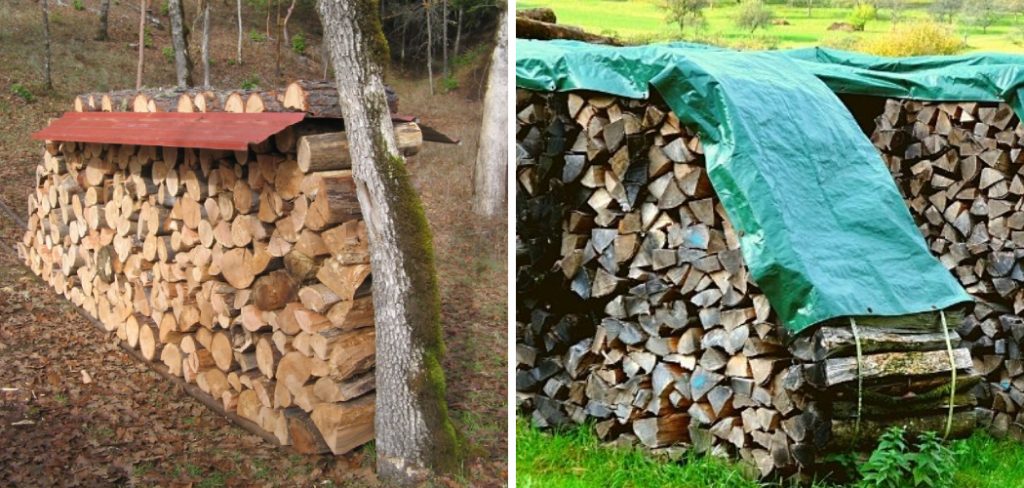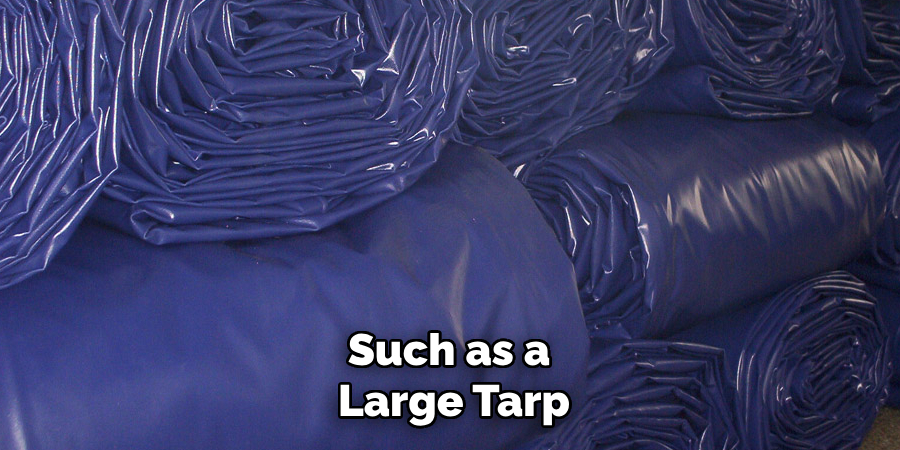Covering firewood properly is essential for maintaining its quality and ensuring it burns efficiently. When left exposed to the elements, firewood becomes susceptible to moisture, which can lead to rot and a decrease in burn efficiency.

Additionally, covering firewood protects it from pests, such as insects and rodents, which can infest and damage the logs. This article aims to provide effective methods on how to cover firewood, ensuring that it remains dry and ready for use throughout the seasons.
By implementing the right techniques and using appropriate materials, you can safeguard your firewood against rain, snow, and other harmful conditions, ultimately enhancing your overall firewood storage practices.
Selecting the Right Location
Choosing an Elevated Spot
Selecting the right location for your firewood stack is crucial to prevent moisture absorption. Keeping firewood off the ground helps to shield it from direct contact with soil, which can retain moisture and lead to rotting.
Using pallets, racks, or bricks to elevate your firewood stack is an effective strategy. These materials create a barrier that allows air to circulate underneath, helping to maintain a dry environment. By lifting the firewood, you also reduce the risk of insect infestations, ensuring that your logs remain in the best possible condition for burning.
Finding a Well-Ventilated Area
Another important consideration when storing firewood is to choose a well-ventilated area. Ensuring good airflow around your firewood not only aids in drying but also helps prevent the growth of mold and mildew.
When selecting a site, avoid corners or enclosed spaces with stagnant air, as these could trap moisture and lead to deterioration over time. Look for locations that receive sunlight and breeze, enabling natural drying and reducing humidity levels. A well-ventilated stack will ultimately lead to better-burning efficiency when the firewood is needed.
Materials Needed for Covering Firewood
Cover Materials

Using the right materials is essential to effectively covering your firewood. A durable tarp is an excellent choice, as it is waterproof and readily available in various sizes, making it easy to find one that fits your firewood stack.
Additionally, metal or plastic sheets can serve as sturdy options for long-term coverage, providing a robust barrier against the elements. These materials shield the wood from rain and snow and help maintain air circulation when properly configured.
Securing Materials
Securing your cover is crucial to ensure it remains in place during windy conditions. Bungee cords, ropes, or weights can fasten the cover tightly against the stack, preventing it from blowing away or sagging.
Moreover, using stakes or poles can elevate the cover, which is important for preventing water from pooling on top. Elevating the cover creates space for air to circulate around the firewood, further protecting it from moisture buildup and promoting a dry storage environment.
Properly securing your cover will enhance the longevity and quality of your firewood throughout storage.
How to Cover Firewood: Step-by-Step Guide
Preparing the Firewood Stack
Before applying a cover, preparing your firewood stack properly is essential. First, stack the firewood in a crisscross or pyramid shape. This arrangement provides stability and is less likely to topple over, even in windy conditions. As you stack the logs, ensure that you leave intentional gaps between them.
These gaps are crucial as they promote better air circulation, which aids in drying out the wood and reducing moisture retention. A well-prepared stack optimizes airflow and helps mitigate the risk of mold and mildew growth.
Additionally, consider the orientation of your stack—aim it towards the sun, if possible, to harness natural warmth for quicker drying. This initial preparation sets the stage for effective covering, ensuring your firewood remains in the best condition for burning.
Applying the Cover

Once your firewood stack is ready, it’s time to apply the cover. Begin by selecting a suitable cover, such as a large tarp to drape over the entire stack.
Place the cover over the top of the firewood, ensuring it is securely positioned to shield from rain and snow. However, it’s important not to cover the sides completely; leave them partially exposed to allow for airflow and ventilation. Proper ventilation helps to prevent moisture buildup, which can lead to spoilage. After positioning the cover, secure it using bungee cords, ropes, or weights.
These securing methods will help keep the cover in place, especially during windy conditions, and prevent it from sagging or blowing away. By following these steps, you can ensure that the firewood remains well-protected while promoting airflow.
Ensuring Proper Ventilation
Ensuring adequate ventilation is key to maintaining the quality of your covered firewood. To achieve this, elevate the cover using stakes or poles, allowing air to circulate underneath while protecting the top from rain. This elevation prevents water pooling on the cover, which can lead to moisture infiltration.
Adjust the cover to facilitate airflow while safeguarding the logs; for instance, you can tilt it slightly or use adjustable ties to create gaps that encourage ventilation. Regularly inspect the cover to ensure it remains positioned correctly, as shifting may diminish airflow effectiveness. Additionally, if you notice any signs of moisture on the logs or if the air feels stagnant, consider making further adjustments to enhance airflow.
By prioritizing ventilation, you are protecting your firewood from the elements and ensuring it stays dry and ready for use when needed.
Seasonal Considerations
When it comes to storing firewood, seasonal changes can significantly impact your covering strategy. Each season presents unique challenges; therefore, adjusting your approach is essential for maintaining wood quality throughout the year.
Winter Covering Tips

In winter, it’s crucial to use thicker and more durable covers to combat harsh conditions like snow and ice. Heavy-duty tarps or plastic sheeting can provide better insulation against the elements, protecting your firewood from moisture buildup.
Additionally, it’s important to check and adjust the cover regularly to remove any snow accumulation. Snow can weigh down the cover, leading to potential sagging and restricted airflow, which may damage the logs beneath. Ensuring that the cover remains taut and clear of snow helps maintain a dry and ventilated environment.
Summer Covering Tips
During the warmer months, lighter covers offer protection from both sun and rain while ensuring maximum airflow. Lightweight tarps or breathable fabric can shield the firewood from excessive heat and moisture without trapping humidity.
Regularly checking for pests and clearing debris from around the stack is equally important, as this helps prevent infestations and provides a clean environment for your firewood. By making these seasonal adjustments, you can protect your firewood throughout the year, ensuring it’s ready for use when needed.
Maintaining Covered Firewood
Properly maintaining your covered firewood is essential to ensure its longevity and usability. Regular inspections play a crucial role in this process, allowing you to identify any potential issues before they escalate.
It’s important to monitor the condition of both the cover and the firewood stack. Look for signs of damage such as tears in the cover or excessive moisture on the logs. Adjust the positioning of the cover as necessary to maintain optimal protection against the elements, particularly after storms or strong winds.
Regularly checking on your firewood will help you catch problems early and keep it in prime condition for burning.
01.Regular Inspections
Conducting routine inspections of your firewood stack is vital to maintaining its quality. Aim to check the cover at least once a month, ensuring that it remains secure and in good shape. Look out for any moisture seeping through or pooling on top of the cover; this could indicate that adjustments are needed.
Additionally, inspect the wood, checking for any dampness or signs of mold. Making these inspections a habit will help ensure your firewood remains dry and ready for use.
02.Preventing Pests
To keep your firewood stack in excellent condition, preventing pests from setting up residences nearby is essential.

Start by keeping the area surrounding the stack clean and debris-free, as this can attract rodents and insects. Consider using natural repellents like essential oils to discourage pests from approaching.
Additionally, traps can effectively deter unwanted visitors and protect your firewood from potential infestations. Regularly maintaining this environment safeguards your wood and promotes a healthier storage area.
03.Troubleshooting Common Issues
Despite taking precautions, issues may still arise when storing covered firewood. Knowing how to troubleshoot these common problems can help maintain the integrity of your woodpile and ensure it remains ready for use.
04.Dealing with Water Accumulation
Water accumulation on your cover can significantly risk your firewood quality. To combat this, ensure the cover is angled properly to encourage drainage and prevent water pooling in one area.
Using additional stakes or supports can enhance drainage by creating a sloped surface that directs rainwater away from the logs. Regularly inspect the cover for sagging or bulging, adjusting as necessary to maintain the proper angle and keep your firewood dry.
05.Addressing Mold and Mildew
Mold and mildew can develop when moisture becomes trapped in your firewood stack. To mitigate this, increase ventilation by adjusting the cover or repositioning the stack for better airflow. Removing and properly disposing of any moldy or damp wood is essential, as it can compromise the rest of your firewood.
Ensuring a dry and well-ventilated storage area is key to preventing future growth, thereby keeping your wood in optimal condition for burning. Regular maintenance and swift action will help you effectively tackle these common issues.
Alternative Covering Methods
Using a Firewood Shed

Building or purchasing a firewood shed can provide optimal protection and airflow for your firewood. A dedicated shed keeps wood sheltered from harsh weather conditions while promoting ventilation. However, the initial investment can be higher than traditional covering methods, and maintaining the shed may require additional effort.
Natural Coverings
Natural materials such as branches or leaves can serve as temporary covers for firewood. While these materials can provide some protection against the elements, their effectiveness is limited, as they may not shield against heavy rain or pests. Additionally, natural coverings can degrade quickly, necessitating regular replacement.
Conclusion
In summary, knowing how to cover firewood effectively is crucial for maintaining its quality and ensuring optimal burning conditions. Key steps include using appropriate covers for different seasons, performing regular inspections to identify potential issues, and preventing pests by keeping the surrounding area clean.
Properly angled covers can help combat water accumulation while promoting ventilation, which is vital in preventing mold and mildew. Incorporating these practices into your routine establishes a proactive approach to firewood care.
Remember, consistent maintenance and timely adjustments are essential in preserving the integrity of your firewood stack. Following these tips, you can ensure your firewood remains well-protected and dry, ready to provide warmth and comfort. Taking the time to cover and maintain your firewood will ultimately lead to more efficient and enjoyable burning experiences.
About the Author
Adrian Green, a lifelong woodworking enthusiast, shares his passion for the craft through The Woodenify Blog. With a foundation built on years of hands-on experience in his father’s woodworking shop, Adrian is dedicated to helping others learn and grow in the world of DIY woodworking. His approach to woodworking combines creativity, practicality, and a deep appreciation for the art of building with your own hands. Through his blog, he inspires individuals of all skill levels to embark on their own woodworking journeys, creating beautiful, functional pieces of furniture and décor.
Professional Focus
- Specializes in DIY woodworking projects, from furniture to home décor.
- Provides step-by-step guides and practical tutorials for woodworkers of all skill levels.
- Dedicated to helping readers build confidence and skill through easy-to-follow instructions and tips.
- Passionate about fostering a community of makers who can share, learn, and grow together.
Education History
- University of Craft and Design – Bachelor of Fine Arts (BFA) in Woodworking and Furniture Design
- Woodworking Apprenticeships – Extensive hands-on training with skilled craftsmen to refine carpentry and furniture making techniques.
- Online Courses & Masterclasses – Continued education in advanced woodworking techniques, design principles, and specialized tools
Expertise:
- DIY woodworking, carpentry, furniture making, and home décor projects.
- Creating accessible tutorials and guides for beginner to advanced woodworkers.
- Sharing the joys and satisfaction of woodworking, from raw materials to finished products.
